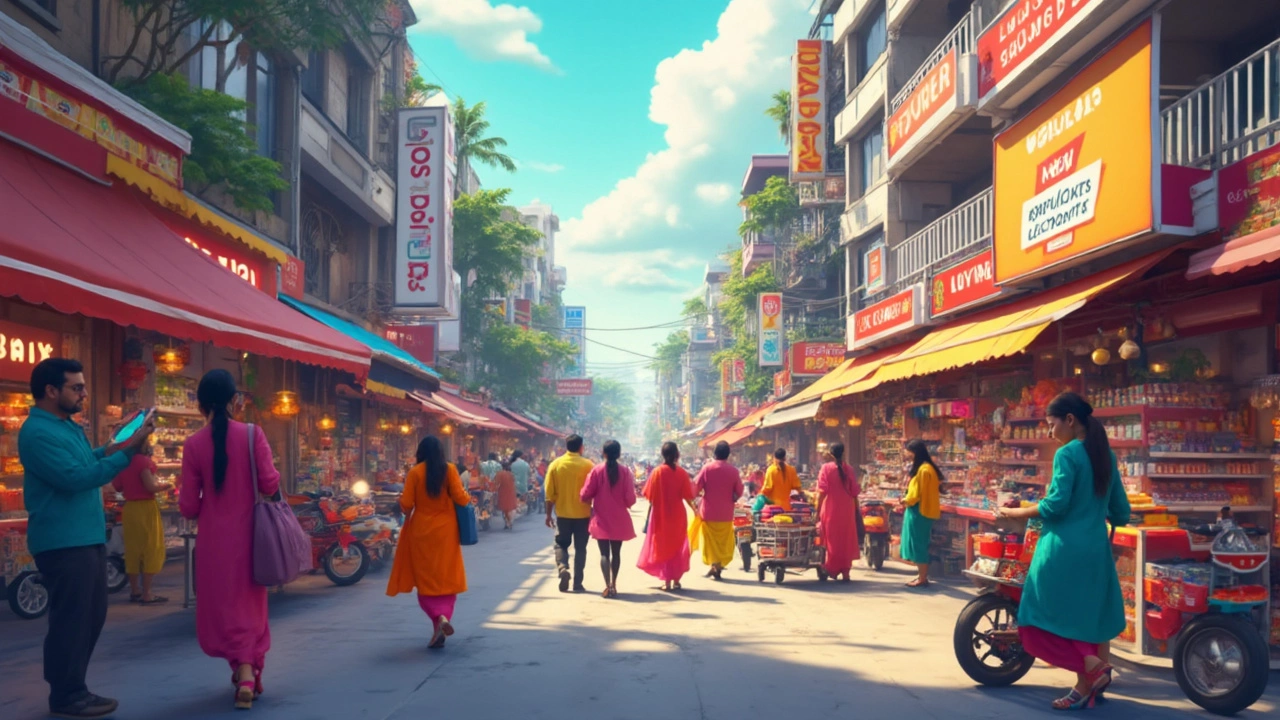Ask anyone what’s the hottest business in India now, and ecommerce will come up every time. But here’s the thing—a decade ago, nobody thought ordering groceries online would become normal in Indian homes, or that teenagers would buy everything from makeup to sneakers through social media links. Yet, that’s what’s going on.
Today, small towns are driving crazy growth numbers. People aren’t just looking for discounts but expecting variety, fast delivery, and sometimes, that local mithai in a nearby city. The success story isn’t only about big players like Flipkart or Reliance Digital. Hundreds of niche startups and spirited local brands are making their mark as trusted shopping spots for millions.
If you’re thinking of diving in as a seller or just want to grab the latest trends, it’s smart to know what’s driving this wave. The pandemic kickstarted things, but now things are only getting bigger, with better payment options, reliable delivery even in villages, and a smartphone in every hand. That’s a goldmine for businesses that know what people want and how to reach them.
- India’s Ecommerce Surge: What’s Fueling the Growth?
- Hot Niches: Beyond Electronics and Fashion
- Local Flavor: Small Brands and Regional Platforms
- Social Commerce: The New Wave
- Key Platforms: Who’s Winning and Why
- Smart Moves: Tips for Success in Indian Ecommerce
India’s Ecommerce Surge: What’s Fueling the Growth?
Ecommerce has exploded in India over the last few years, and it feels like everyone’s shopping online these days. You see a neighbor getting packages every other day, and even your local shopkeeper is now talking about selling on the internet. But what’s really behind this surge?
First, there’s smartphone access. Over 700 million Indians now have smartphones. Almost everywhere you turn, people are tapping away, checking out new deals or tracking parcels. The growth isn’t just in cities; a lot of first-time online shoppers are now in tier-2 and tier-3 towns. It’s not just about being connected; it’s about having easy access to shopping apps, fast payment gateways like UPI, and reliable delivery at your doorstep.
Here’s another big win: India’s digital payment systems are smooth and quick. That old fear about card fraud is fading with secure options like UPI, Paytm, and Google Pay. Shoppers hit ‘Buy Now’ without a second thought because they trust the technology.
Cheap data plans have cut down costs for everyone. Most people aren’t worried about how much time they spend browsing online stores anymore. Combine that with discounts, lightning sales, and easy returns, and you’ve got a recipe for millions of new digital buyers every month.
“India’s ecommerce market could reach $350 billion by 2030, making it the third largest in the world,” said Satish Meena, an ecommerce analyst formerly with Forrester Research.
Have a look at how the numbers stack up:
| Year | Online Shoppers (Millions) | Ecommerce Market Size (USD Billion) |
|---|---|---|
| 2018 | 120 | 30 |
| 2021 | 200 | 84 |
| 2024 | 350 | 133 |
This rapid climb shows why investors, brands, and even kirana stores are eyeing a piece of the ecommerce pie. The ecommerce wave in India is powered by digital payments, cheap data, and a hungry young population ready to try new things.
- Mobile access and cheap data plans are driving first-time shoppers.
- Digital payments have made shopping seamless and secure.
- Faster logistics mean even remote areas are getting deliveries within days.
- Pandemic lockdowns made online shopping a habit that’s here to stay.
If you’re thinking this growth spurt will slow down, think again. With the push towards hyperlocal delivery, regional language apps, and affordable smartphones, India's ecommerce story is just getting started.
Hot Niches: Beyond Electronics and Fashion
There’s more to ecommerce in India than smartphones and clothes. People are now flocking to buy groceries, health supplements, and pet supplies online—stuff nobody thought would be big online just five years ago. The grocery segment alone is exploding, hitting around $25 billion in 2024, up from $3 billion just five years ago, according to Statista. Online pharmacies, personal care, and baby products have seen wild demand thanks to super-fast delivery and easy returns.
Then you’ve got home improvement—everything from modular kitchens to ready-to-use tool kits. IKEA, Pepperfry, and local online brands have their hands full with requests for customized furniture and decor. Even fitness gear and smart home gadgets are selling faster than sellers can restock. Just scroll through any leading site, and you’ll see how deep these categories go.
"We saw a 180% jump in orders for skincare, pet care, and daily supplies from Tier-2 cities during 2023. The real growth story is outside the metros now." — Meera Menon, Head of Strategy at BigBasket
If you’re thinking this is all limited to big cities, think again. Demand from smaller towns drives much of the new business—consumers want quality products delivered fast, even if they live far away from warehouses or malls.
Here’s a quick look at which categories are gaining serious traction:
- Grocery and fresh food delivery
- Pharmacy and wellness products
- Home and kitchen improvements
- Beauty and personal care
- Pet foods and accessories
- Stationery, books, and learning tools
Check out these numbers on recent growth in some top niches:
| Niche | 2020 Market Size (USD bn) | 2024 Market Size (USD bn) | Growth (%) |
|---|---|---|---|
| Online Grocery | 3 | 25 | +733% |
| Pet Care | 0.4 | 1.3 | +225% |
| Pharma & Wellness | 1 | 5.7 | +470% |
| Home & Furniture | 2.5 | 7.5 | +200% |
The main lesson? Anyone aiming to break into ecommerce in India now has a bunch of options outside the usual tech and fashion. These hot segments are where big opportunities are hiding—and there’s a clear customer demand for anyone willing to fill the gap.
Local Flavor: Small Brands and Regional Platforms
India's ecommerce isn't just about national giants. Regional platforms and homegrown brands are killing it, especially in Tier 2 and Tier 3 cities. Take Meesho for example—it's a marketplace made for small sellers, and it's got over 140 million users as of early 2025. Most of them are first-time online shoppers, proving there's real appetite for local stuff, not just international drops.
Smaller players like VilCart, Zoff Foods, and even Chumbak have tapped into local tastes and managed to keep things affordable. VilCart connects rural stores to suppliers, letting shop owners in villages source their stock with ease. Meanwhile, Chumbak started as a funky souvenir brand and is now a full lifestyle platform with a strong online presence—and is proof that you don't need to start big to go national.
Regional language support is key. A 2023 report by RedSeer said more than 50% of ecommerce growth in India comes from content and support in languages other than English. That's why platforms like JioMart and ShopClues invest in Hindi, Tamil, and Marathi interfaces and ads. People want to shop in a language they get—this makes the whole process less intimidating.
| Platform | Main Focus | Target Region/Cities | Year Founded |
|---|---|---|---|
| Meesho | Reselling, Lifestyle | All India, especially Tier 2/3 | 2015 |
| VilCart | B2B Distribution | Rural Karnataka, now expanding | 2018 |
| Chumbak | Home, Decor, Fashion | Urban & semi-urban | 2010 |
| ShopClues | Value E-commerce | Northern & Western India | 2011 |
If you run a local business, don't sleep on ecommerce. The right platform, regional lingo, and a focus on what people in your area crave can put you right up there with the big players. More shoppers trust products that feel familiar, and that's where small brands can totally shine. If you want your business to stand out, double down on that personal touch and local flavor—the big stores can't fake that.
And here’s the kicker: ecommerce is turning word-of-mouth digital now, so if your product hits the right notes, people hit that share button faster than ever. Local brands have cracked the code by staying relatable, affordable, and—most importantly—present in people’s everyday lives.

Social Commerce: The New Wave
If you thought ecommerce was just about websites and apps, you’re missing the real action. Social commerce is completely flipping the script in India. This isn’t hype—according to Bain & Company, India’s social commerce market was worth around $8-9 billion in 2023 and could reach $50 billion by 2030. That’s not a typo.
What’s driving this? People spend hours on WhatsApp, Instagram, and Facebook. With shopping features built right in, you can spot a product in a reel, tap, and buy. No switching apps. Even small businesses—think sari sellers in Surat or homemade pickles from Kerala—are running their shops through WhatsApp groups or Instagram Stories.
Here’s what makes social commerce in India explode:
- ecommerce platforms are integrating with social networks, making selling and buying super easy.
- Micro and nano influencers—normal folks with loyal followers—are driving sales with real-life demos and reviews.
- Payments happen right inside chat apps, with UPI making things super simple.
- Language isn’t a roadblock. Sellers and buyers trade in Hindi, Tamil, Bengali, and even Hinglish, reaching everyone from big cities to tiny villages.
Let’s look at the numbers that show just how fast this is growing:
| Year | Estimated Market Size (USD Billion) | Active Users (Millions) |
|---|---|---|
| 2021 | 2.8 | 68 |
| 2023 | 8.5 | 120 |
| 2025 (projected) | 20 | 200+ |
Platforms like Meesho, Shop101, and GlowRoad jump-started this boom by letting sellers start their businesses with pretty much zero investment. If you want in, here’s what works best:
- Pick the right platform: If you target first-time buyers, Meesho and WhatsApp might work better than Amazon.
- Use short videos and stories: Show your product, don’t just post static pictures.
- Offer easy payments: UPI is the gold standard in India—don’t ignore it.
- Build trust: Quick replies, personal touches, and easy returns are why people keep coming back.
Social commerce removes a ton of friction from shopping. It feels personal and local, so people are more likely to try a new brand or shop from their friends. As more Indians get online, expect this wave to get even bigger.
Key Platforms: Who’s Winning and Why
When it comes to ecommerce in India, a handful of giants grab most of the headlines, but others are shaking things up in very specific ways. Flipkart and Amazon stay on top for pretty much everything—electronics, clothes, home stuff—you name it. Flipkart especially nails cash-on-delivery options and festival sales, which Indian shoppers love. Amazon wins big because of super-fast delivery, handy Prime deals, and a smooth app that even first-time buyers find easy.
But it’s not all about the top two. Here’s who else is making serious gains:
- Meesho: This platform exploded by helping small sellers, especially women, start online businesses without any upfront costs. They offer a “zero-commission” model, which has made it a favorite for low-priced fashion and home items. In 2024, Meesho ranked among the most downloaded shopping apps in India.
- Nykaa: All about beauty products, Nykaa found a gap and filled it—now it’s the go-to app for cosmetics, skincare, and everything related, with a ton of new brands and exclusive launches. Nykaa’s YouTube tutorials and influencer marketing changed how Indians discover and shop for makeup.
- JioMart: With Reliance backing it, JioMart is quietly taking over groceries, especially in semi-urban and rural places. They focus on fresh produce, low prices, and super reliable delivery, which is a big deal outside top cities.
- Marketplaces for Used Goods: OLX and Quikr aren’t flashy, but millions use them. They let regular folks buy and sell second-hand things, everything from bikes to furniture. These platforms thrive because Indians love a good bargain, and nothing beats getting legit deals from people nearby.
These companies are winning because they get what makes the Indian market tick. They localize their content, tap into regional languages, and don’t make shopping feel complicated. Platforms that offer simple payment options, stellar customer support, and regular deals tend to build trust quickly. Looks like the race isn’t just about size anymore; it’s about knowing your customer better than the next guy and moving fast.
Smart Moves: Tips for Success in Indian Ecommerce
If you want to do well in the Indian ecommerce scene, you need more than just a catchy product or a nice website. Indian customers are picky, and there’s heavy competition. Here’s what top sellers and brands are actually doing to stay ahead.
- Know your audience inside out – Data shows that almost 65% of online shoppers in India are below 35. Tier-2 and tier-3 cities are where the big growth is happening. Young buyers demand mobile-friendly layouts, fast load times, and regional language support. Don’t ignore these basics.
- Offer simple and reliable payment methods – While UPI is king (as of 2025, UPI accounts for over 75% of online transactions), you’ll win points if you also support wallets, COD, and even Pay Later options. Payment failures or confusion lose customers fast.
- Focus on logistics – Same-day or next-day delivery isn’t just for the big guys. Local partnerships and smart warehousing mean even smaller sellers can hit these speeds. For example, Meesho scaled in smaller cities by teaming up with hyperlocal delivery startups.
- Tap into social commerce – Indians spend over 2.5 hours a day on social media, and shopping through platforms like Instagram and WhatsApp is up 60% year over year. Showcase your products where your buyers already hang out. Running live video demos or using regional influencers can bring in serious sales.
- Leverage marketplace tools – Selling on platforms like Amazon India or Flipkart brings built-in traffic. But don’t just list and hope. Use their marketing tools—run sponsored ads, try lightning deals, and always answer customer questions quickly.
- Build trust – Trust is a big deal in Indian ecommerce. This means easy returns, transparent reviews, and customer support that actually responds. A lack of clarity pushes buyers away.
| Fact | Detail |
|---|---|
| Total Online Shoppers | Over 330 million |
| UPI Share in Payments | 75%+ |
| New Shoppers from Tier-2/3/4 Cities (2024 growth) | 70% of new users |
| Popular Shopping Platforms | Flipkart, Amazon, Meesho, JioMart, Nykaa |
| Average Cart Abandonment Rate | ~65% |
One major thing—don’t overload your buyers with too many options or confusing offers. Keep things clear. And don’t forget to promote seasonal discounts; Diwali sales still see site traffic and sales spike by up to 80% in a single week.
To sum it up, success in ecommerce platforms in India isn’t just about what you sell—it’s about smart delivery, daily connection with users, and always staying on top of what customers demand.


